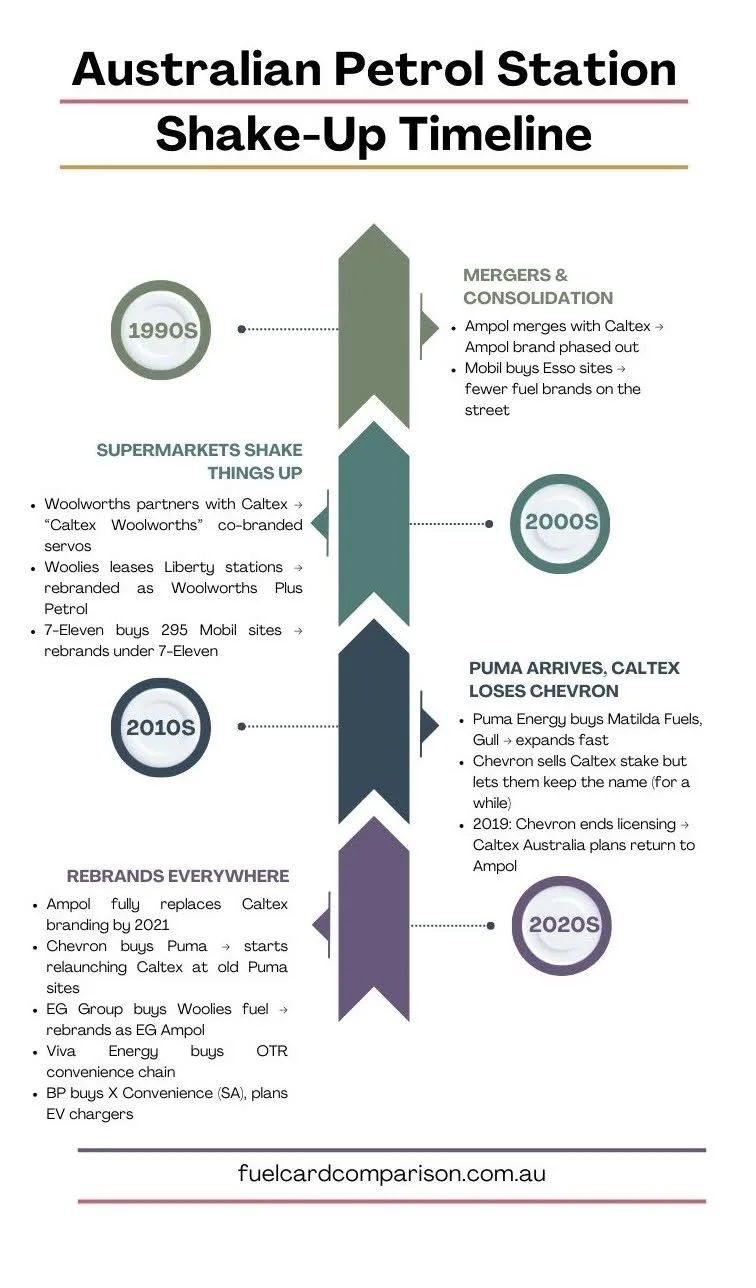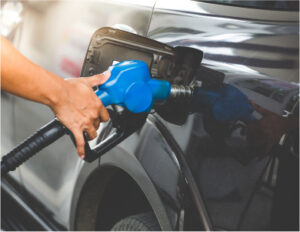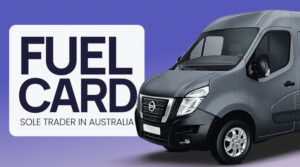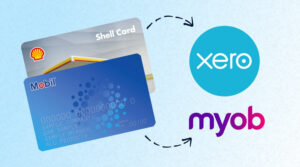If you’ve ever pulled into a servo and thought, “Wait… wasn’t this a Caltex last week? Or was it an Ampol? Or maybe it used to be Puma?”… you’re not alone.
The world of petrol stations in Australia has been a confusing ride over the past few decades. Between rebrands, mergers, supermarket tie-ups, and global fuel giants buying and selling local networks, it feels like the logos have been playing musical chairs.
In fact, if you zoom out, the last 30 years have been a story of consolidation, relaunches, and a whole lot of brand overlap. We’ve gone from a landscape dominated by Aussie names like Ampol, to a period where global brands like Caltex and Chevron took over, to a weird present-day reality where… well, we kind of have two Caltexes.
So, how did we get here? And why do some servos fly the same flag but aren’t really connected? Here’s a breakdown of what’s happened, and why Australia’s petrol station landscape looks like it does today.
A Timeline of Australia’s Petrol Stations (1990s – 2025)
So, how exactly did Australia’s petrol station landscape get so confusing? Let’s break it down decade by decade.

Read more about what the changing state of fuel brands in Australia means for your business.
1990s: When Ampol and Caltex got together
Back in the ‘90s, Aussie drivers were used to seeing Ampol around. But in 1995, Ampol merged with Caltex, and over time, most Ampol signs disappeared, replaced by Caltex.
At the same time, global oil giants like Mobil were snapping up Esso stations, consolidating the industry.
2000s: Enter the supermarkets (and 7-Eleven gets in on the action)
The 2000s were all about fuel + groceries = discounts. Woolworths started leasing Liberty Oil sites in 2001, turning them into Woolworths Plus Petrol. Then in 2003, Woolies teamed up with Caltex to co-brand hundreds of servos as Caltex Woolworths. Suddenly your grocery docket could save you a few cents a litre.
Meanwhile, 7-Eleven was making moves. In 2010, they bought almost 300 Mobil stations and rebranded them under the 7-Eleven banner. This deal made 7-Eleven the largest independent fuel retailer in Australia. While the deal was initially expected to lead ExxonMobil to exit downstream operations in Australia, the companies later announced that Mobil branding would be reintroduced to some 7-Eleven stations.
2010s: A new player (Puma) and a lot of global chess moves
In the early 2010s Puma Energy started popping up everywhere. They snapped up smaller regional chains like Matilda Fuels and Gull Petroleum and quickly became a big independent player.
But the real confusion kicked off in 2015, when Chevron (who owned the Caltex brand globally) sold its stake in Caltex Australia… but let them keep using the Caltex name under license.
It worked for a while, until 2019, when Chevron pulled the pin. No more license meant Caltex Australia had to find a new name. Enter: Ampol, reborn. By the end of the decade, the Ampol name was back on the streets.

Check Your Fuel Card Eligibility
2020s: Everyone rebrands, and now we have two Caltexes (somehow)
The 2020s started with even more musical chairs. Chevron bought Puma Energy’s Australian business in 2020 and decided to start using the Caltex name again.
So now, you’ve got Chevron-owned Caltex stations popping up… at the same time as Ampol-owned stations that used to be called Caltex but aren’t anymore.
Confused? Yeah, so’s everyone else.
Meanwhile, Ampol wrapped up converting all its old Caltex sites to Ampol branding by 2021. On another front, EG Group (a UK company) had bought Woolworths’ petrol business in 2019 and kept selling fuel under the EG Ampol brand, so you’ve also got those sites sprinkled around.
To add more spice, Viva Energy (which runs Shell in Australia) bought OTR (On The Run) convenience stores in 2023. And in 2024, BP swooped in and acquired X Convenience in South Australia, adding even more logos (and some plans for EV chargers) to the mix.
Where does that leave us in 2025?
Australia’s petrol station scene has been one long game of musical brands. Some servos switched signs three or four times in a decade. And standing at the pump, you might be buying fuel from Ampol, but at a station owned by EG, carrying a Woolworths loyalty deal, on a site that used to be Liberty, co-branded with Caltex.
The Supermarket Effect: How Fuel Became a Grocery Game
Here’s where things got even more tangled: supermarkets got involved. Back in the early 2000s, the big grocery chains realised that selling petrol wasn’t just about fuel, it was a way to lock in loyalty. Enter the fuel discount docket.
- Woolworths kicked it off by leasing Liberty Oil sites in 2001, rebranding them as Woolworths Plus Petrol. Suddenly, filling up and shopping at Woolies were linked.
- Then in 2003, Woolworths partnered with Caltex, and over 400 servos became Caltex Woolworths.
Not to be left out, Coles teamed up with Shell, launching Coles Express with the same deal: spend at Coles, save at the pump.
And just like that, petrol stations weren’t just about fuel anymore, they were tied to grocery loyalty schemes. Fast forward to 2019, and Woolworths sold its entire petrol business (over 500 sites) to EG Group, a UK-based company.
Even though EG took over the stations, they kept the Woolworths Everyday Rewards program. So your grocery points? Still worked at the pump, except now at EG Ampol sites (because EG sources its fuel from Ampol).
Meanwhile, Coles Express stayed tied to Shell, with Flybuys points still going strong.
Why does this matter?
Because depending on where you shop, you’re probably tied into a fuel brand, whether you realise it or not. Grocery spending = fuel discounts = where you fill up = which loyalty program you’re stuck with.
In other words, supermarkets turned servos into an extension of your weekly shop, and that’s a big reason Australia’s petrol station market is so interconnected (and confusing).
Ampol vs Caltex: Wait… aren’t they the same?
If there’s one thing that’s tripped up Aussie drivers in the past few years, it’s this:
“Why are there still Caltex stations… but also Ampol stations? Didn’t Caltex turn into Ampol?”
Yeah. Fair question. And the answer’s a bit of a corporate soap opera. Here’s what happened:
Ampol’s been around since the 1930s (it originally stood for Australian Motorists Petrol Company). But in the ‘90s, it merged with Caltex and the Ampol name faded away, everything got rebranded as Caltex.
For a long time, Caltex Australia operated under a licensing agreement with Chevron, the global owner of the Caltex brand. But in 2019, Chevron pulled the pin and ended the license.
That meant Caltex Australia couldn’t use the Caltex name anymore. So what did they do? They dusted off the old Ampol brand and brought it back. From 2020 onwards, all Caltex Australia stations started getting new signs: Caltex out, Ampol in.
Sounds simple, right? Here’s where it gets tricky.
At the same time, Chevron (the global Caltex owner) decided it wasn’t done with Australia. It bought Puma Energy’s Aussie operations in 2020, and started rebranding those Puma stations back to Caltex.
So now we’ve got:
- Ampol-owned stations (previously branded Caltex, now Ampol)
- Chevron-owned stations (previously Puma, now Caltex)
Both selling fuel under similar branding… but totally separate companies.
If you’ve seen two Caltex stations in the same town, one that’s actually Ampol in disguise, and one that’s the “new” Chevron Caltex, you’re not imagining things. It’s real.
And just to make it more tangled? Some Woolworths Caltex sites became EG Ampol (owned by EG Group, fuel supplied by Ampol, but operated separately).
Basically, over the past few years, the same servo might’ve gone:
Caltex Woolworths → EG Caltex → EG Ampol.
No wonder everyone’s confused.
The Rise of the Independent Fuel Stations (and Why They Matter)
While the big brands were busy merging, rebranding, and swapping logos, a different kind of player was growing: independent fuel chains.
Names like United Petroleum, Metro Petroleum, Liberty, APCO, Gull, Vibe, Speedway, Tas Petroleum – you’ve probably driven past at least one of these. They don’t have the global muscle of BP or Shell, but they’ve carved out a huge share of the market, especially in regional areas.
These independents built their networks in places the big brands were pulling back from. Small towns, highways, truck stops, places where locals just wanted reliable fuel, cheaper prices, and maybe a pie and a coffee.
But now, many of these independents aren’t actually independent anymore. Take Liberty: it struck a deal with Viva Energy (the company behind Shell in Australia) to supply fuel.
Or Gull Petroleum, which got scooped up by Puma Energy in 2017, and then indirectly became part of Chevron’s network when Chevron bought Puma in 2020.
United Petroleum remains a big Australian-owned operator, and has even tried listing on the stock exchange a few times. They’ve grown by snapping up sites and selling fuel on thin margins to stay competitive.
In some cases, these independents are still fuelled by the majors, buying wholesale fuel from BP, Ampol, or Viva, but flying their own flag. You might be filling up at Metro, but the tanker dropping off fuel might be branded Shell.

Check Your Fuel Card Eligibility
Why does this matter?
Because it’s another layer of confusion for drivers: the sign out front doesn’t always tell you who’s actually supplying the fuel, or which card or discount program will work there.
The independents are often cheaper, but might not take the same fuel cards, loyalty programs, or discounts tied to the majors. And in a post-merger, post-rebrand landscape, they’re playing an even bigger role in keeping competition alive outside the city.
Read more: Does fuel quality vary between petrol stations?
The Rise of Convenience Retail
Here’s something you’ve probably noticed over the years: petrol stations aren’t just about petrol anymore. They’ve turned into mini supermarkets, coffee stops, and fast food joints.
And that’s no accident.
Starting in the 2000s, fuel companies realised that the real money wasn’t in the fuel, it was in what you bought while you were filling up. With petrol margins getting squeezed, the profits had to come from snacks, drinks, coffee, food, groceries, and car washes.
That’s why servos started to feel more like convenience stores with bowsers out front.
Some of the biggest moves:
- 7-Eleven: When they took over Mobil sites in 2009, they didn’t just rebrand them, they turned them into proper 7-Eleven convenience stores, complete with Slurpees, Krispy Kremes, and snacks.
- Coles Express: Pushed coffee, sandwiches, and meal deals alongside Flybuys points.
- Ampol Foodary: Ampol’s own retail concept, revamping its stores into modern cafés and food shops, with barista-made coffee and grocery basics.
- OTR (On The Run): In South Australia especially, these became the gold standard for full-service convenience stops: coffee, bakery, salads, sushi, even fresh fruit. That success is a big reason Viva Energy bought OTR in 2023.
Even independents followed suit. Walk into a Metro or APCO these days and you’ll find hot food counters, bakery sections, and shelves of grocery items.
Why? Because drivers aren’t just stopping for fuel – they’re grabbing lunch, a snack, a coffee, or picking up milk on the way home.
This shift toward “non-fuel revenue” means petrol stations are trying to compete with cafés, fast food chains, and corner shops all at once. And as electric vehicles slowly take hold, the plan is that drivers will stop and spend even more time (and money) inside while their car charges outside.
The Next Frontier: Electric Vehicle Charging at Servos
As if Australia’s petrol station game wasn’t complicated enough, here’s the next twist:
servos are becoming charging hubs.
Over the past few years, the big fuel companies have started rolling out electric vehicle (EV) charging stations at their forecourts. The idea? If drivers aren’t filling up with petrol, they’ll still stop in to plug in, and hopefully spend money at the shop while they wait.
Here’s what’s happening:
- BP launched its “bp pulse” network, aiming to roll out hundreds of fast chargers across Australia by 2030.
- Ampol is building its “AmpCharge” network, targeting both metro and regional locations, often co-located with its petrol stations.
- Shell (Viva Energy) acquired part of the Chargefox network in 2022, locking in fast chargers at key sites.
At the same time, new EV-specific charging brands (like Evie Networks and Tesla Superchargers) are popping up at shopping centres and highway rest stops, giving petrol stations some fresh competition.
But EV charging takes longer than filling a tank. So servos are pivoting hard into food, coffee, seating, and convenience retail to keep you busy (and spending) while your car charges.
We’re not at full-scale rollout yet (Australia still lags behind Europe and the US in charger numbers) but over the next decade, expect to see more charging bays next to bowsers, and more cafés inside servos.
The petrol station of the future?
It’s looking a lot more like a hybrid between a mini supermarket, café, parcel pick-up hub, and charging station, whether you’re running on petrol, diesel, or pure electricity.
The Petrol Station Landscape Today: Who’s Who in 2025?
So after 30 years of mergers, rebrands, supermarket deals, and surprise comebacks… where does that leave us now?
Here’s the quick rundown of who’s running the show at Australia’s servos in 2025:
Ampol: The big Aussie-owned brand, running over 1,900 stations. You’ll find them at their own Ampol-branded sites, plus at EG Ampol stations (which are owned by EG Group but supplied by Ampol).
Caltex: Yep, still around, but now owned by Chevron directly. These are mostly the old Puma Energy sites, rebranded as Caltex after Chevron’s buyout in 2020.
Shell: Run by Viva Energy in Australia, including their recent acquisition of OTR (On The Run) convenience stores. So in SA especially, you’ll see a lot of Shell-branded servos with OTR shops attached.
BP: Still a big player, with a network of branded servos and supply agreements. In 2024 they snapped up X Convenience in South Australia, adding those sites into their portfolio.
7-Eleven: Dominating the convenience retail side, with hundreds of stores selling fuel under the 7-Eleven banner (since they bought some of Mobil’s sites back in 2009).
EG Ampol: Over 500 former Woolworths stations, now owned by EG Group but still branded “Ampol” and linked to Woolworths Everyday Rewards.
United Petroleum: Still a major independent brand, with hundreds of sites, often pricing aggressively below the majors.
Metro Petroleum, Liberty, APCO, Vibe, Speedway, Tas Petroleum, FuelXpress, Gull: Smaller independent chains filling gaps in the market, especially in regional areas. Some have supply deals with bigger brands behind the scenes.
And don’t forget the loyalty programs. Many stations are still tied into Woolworths Everyday Rewards, Coles Flybuys, or 7-Eleven’s own app deals, so where you shop can still influence where you fill up.
What’s next?
The petrol station isn’t just about petrol anymore. Almost every brand is doubling down on convenience retail: food, coffee, groceries, parcel lockers, car washes. And with EV charging stations rolling out at BP, Ampol, and Shell sites, the next big shift might be what’s pumping through the nozzle.
But for now, if you’re still scratching your head at why your local servo keeps changing signs? Don’t worry, you’re not imagining it. Australia’s petrol game has been playing logo roulette for decades… and the fuel wars are far from over.
So… Where Does My Fuel Card Work?
If the world of petrol stations wasn’t already confusing enough, let’s throw fuel cards into the mix. Fuel cards are basically like charge cards for petrol. You swipe, the company bills you later, and (if you’re lucky) you get discounts or special rates. Sounds simple… until you realise not every fuel card works at every petrol station.
Who takes what?
- AmpolCard → works at Ampol stations… but may not work at the “new” Chevron-owned Caltex stations.
- Caltex StarCard → works at Chevron Caltex stations… but probably not at Ampol stations.
- Shell Card → accepted at Shell/Viva sites, but not BP or Ampol.
- BP Plus → accepted at BP, but not Shell or Ampol.
- FleetCard, Motorpass, WEX → accepted across multiple brands, but might have extra fees or less discounts at independents.
Some fuel cards also work at independent servos like United, Metro, or Liberty, but not all versions of the card do. For example, a United Card might work at Astron (supplied by United)… but a “community” version of the card might not.
In other words, your fuel card controls where you can fill up. And because brands keep merging, rebranding, and swapping supply deals, a servo that took your card last year might not take it now.
So why does this matter?
Because Australia’s fuel station game isn’t just about picking the cheapest bowser. It’s tied up in:
- Which brand owns the station
- Who supplies the fuel
- Which card networks they accept
- Which supermarket loyalty scheme they’re partnered with
If you’re a business managing a fleet, or even just a driver trying to get the most from your card, it’s a constant juggle. Fuel cards were meant to simplify things, but in this shifting landscape, they’ve actually made it more complicated.
No wonder drivers are left wondering: “Can I even use my card here anymore?”
So, how do you keep up?
If you’re tired of guessing which fuel card works where or wondering if you’re missing out on discounts, you can check your eligibility online now.
Our tool breaks down which cards are accepted at which stations, what discounts they offer, and which ones actually make sense for your business or your budget.
Compare cards. Find the right fit. Stop wasting time at the wrong pump.

Check Your Fuel Card Eligibility
FAQs
How many petrol stations are there in Australia?
Australia has around 6,500 petrol stations across the country. That includes the big brands like Ampol, BP, Shell, and Caltex (Chevron), plus independents like United, Metro, and Liberty. It’s actually fewer than we had a couple of decades ago, thanks to mergers and station closures in some areas.
Does Caltex accept AmpolCard?
The “new” Caltex stations (owned by Chevron) don’t accept AmpolCard. AmpolCard is accepted at Ampol-owned stations and EG Ampol sites (the ones owned by EG Group but supplied by Ampol).
Which fuel brand is best in Australia?
Depends what you mean by “best”. If you’re asking about fuel quality, most major brands (Ampol, BP, Shell, Caltex) meet the same Australian standards and regulations. Some brands market their premium fuels (like BP Ultimate, Shell V-Power, Ampol Amplify Premium) as having extra cleaning agents or performance benefits, but for regular day-to-day driving, any reputable servo should do the job.
If you’re thinking about loyalty programs or discounts, “best” might depend on where you shop for groceries or which loyalty scheme you’re part of. Coles shoppers might prefer Shell/Coles Express for Flybuys points; Woolies shoppers might lean toward EG Ampol for Everyday Rewards.
And if you’re chasing the cheapest price? Independents like United, Metro, or Liberty often undercut the majors, especially outside the cities.


